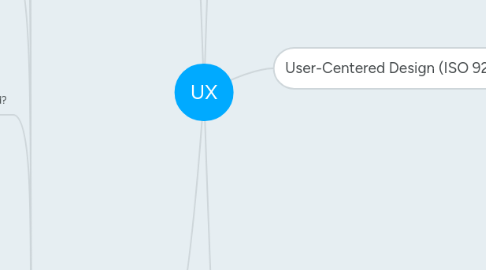
1. UXer must
1.1. Communicate clearly
1.2. Be Open minded
1.3. Technology knowledge
1.4. Problem solving
1.5. User friendly
1.6. Being flexible
1.7. Work as part of a team
2. Feedback
2.1. Info Users
2.1.1. Who are they
2.1.2. What do they do
2.1.3. What like/dislike
2.1.4. what are their goals
2.1.5. what are their experience
2.1.6. What is their behaviour
2.1.7. Gender
2.1.8. Income
2.2. Source
2.2.1. Market Research
2.2.2. Stackholder Conversation
2.2.3. Data Analytics
2.2.4. Survey
2.2.5. Customer Support / Sales
2.3. Recruiting Users
2.3.1. Market Research
2.3.2. University Students
2.3.3. Database of customers
2.3.4. Advertise on the website
2.4. What is it needed?
2.4.1. Recruitment Brief
2.4.2. Background Activities
2.4.3. User details
2.4.4. When and How is the session
2.4.5. Contact Details
2.5. Techniques
2.5.1. Quan
2.5.1.1. Web Analytics
2.5.1.1.1. Patterns of use
2.5.1.1.2. Focus on the problems of the web
2.5.1.1.3. A/B Testing
2.5.1.2. Surveys
2.5.1.2.1. Data driven info
2.5.1.2.2. Closed-ended questions (Yes/No, Multichoice)
2.5.1.2.3. Right Audience
2.5.1.2.4. Question Type/Order
2.5.1.2.5. Language/Method
2.5.2. Qual
2.5.2.1. Focus Groups
2.5.2.1.1. Unbiased
2.5.2.1.2. Observe / Question / Ask
2.5.2.2. Contextual Enquiries
2.5.2.2.1. Visiting users in their context
2.5.2.2.2. 45-120 min
2.5.3. Doc
2.5.3.1. Personas
2.5.3.1.1. Primary
2.5.3.1.2. Secondary
2.5.3.1.3. Gathers
3. Usability (ISO 9441)
3.1. Efficiency
3.2. Ease of Use
3.3. Satisfaction
4. User-Centered Design (ISO 9241)
4.1. Research
4.1.1. User needs
4.1.2. Business needs
4.1.3. Prioritisation
4.2. Design
4.2.1. Information Design (content)
4.2.1.1. User
4.2.1.2. Grouping of info
4.2.1.2.1. Card Sorting
4.2.1.2.2. Information Architecture Validation
4.2.1.2.3. Content Maping
4.2.1.2.4. Content Audit
4.2.1.3. Flow
4.2.1.4. Digest the info
4.2.2. Interaction Design (flow)
4.2.2.1. Desktop Research
4.2.2.2. Brainstorming
4.2.2.3. Collaboration
4.2.2.4. Lo/Hi Fidelity Mockups
4.2.3. Visual Design
4.2.3.1. Brings Info - Interaction Design together
4.2.3.1.1. Conceptualization (2-3 options)
4.2.3.1.2. Mood boards (fresh, dynamic...)
4.2.3.1.3. Style Guide
4.2.3.1.4. Pattern Library
4.2.3.2. Visual cues
4.2.3.3. Mood
4.2.3.4. Usability
4.2.3.5. Sign off
4.3. Evaluation
4.3.1. Usability Walkthroughs
4.3.2. Usability Testing
4.3.2.1. Moderated
4.3.2.1.1. Real users
4.3.2.1.2. Purpose to test system not user
4.3.2.1.3. Tell me my baby is ugly
4.3.2.2. Unmoderated
4.3.3. Expert Review
4.3.4. Competitor Analysis
4.3.5. Feedback
4.3.5.1. Analysing
4.3.5.1.1. Root cause issue
4.3.5.1.2. Users
4.3.5.1.3. Client
4.3.5.1.4. Patterns
4.3.5.2. Reporting
4.3.5.2.1. Format
4.3.5.2.2. Audience
4.3.5.2.3. Language
4.3.5.2.4. Quan vs Qual
4.3.5.2.5. Confirm Objectives

